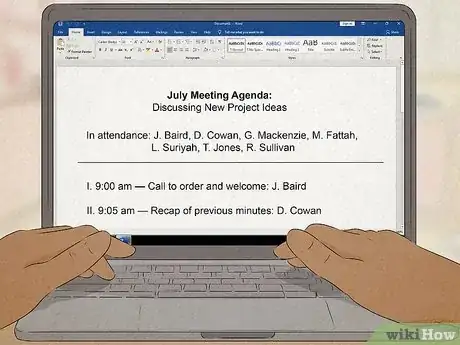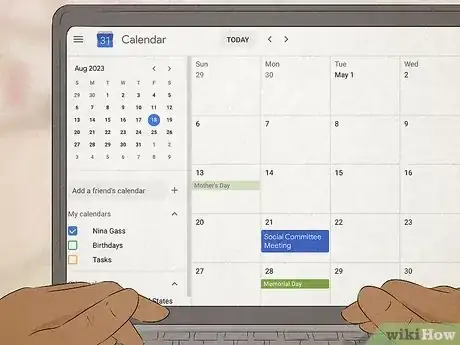This article was co-authored by wikiHow Staff. Our trained team of editors and researchers validate articles for accuracy and comprehensiveness. wikiHow's Content Management Team carefully monitors the work from our editorial staff to ensure that each article is backed by trusted research and meets our high quality standards.
wikiHow marks an article as reader-approved once it receives enough positive feedback. In this case, several readers have written to tell us that this article was helpful to them, earning it our reader-approved status.
This article has been viewed 157,099 times.
Learn more...
Social committees at work can be a fun way to get to know your co-workers and plan special events for them. If your company doesn’t already have one, you can ask your manager or HR representative about starting one. Once you have support, you can begin planning the first meeting and work out all the details for keeping it running smoothly.
Things You Should Know
- Talk to your manager about starting a social committee. Once they're on board, go to human resources for final approval.
- Email your coworkers to let them know you're starting a social committee. Schedule a date and time for the first meeting.
- Aim to recruit around 5-8 members for the committee. If more people are interested, set up a rotating membership schedule so everyone can participate.
Steps
Getting Approval and Support
-
1Find a partner to help get things off the ground. Talk to some of your coworkers during lunch breaks or coffee breaks and see if anyone is interested in helping you get a social committee started. It may be helpful to have a partner to organize the first meeting and stir up interest in the office.
- If no one volunteers to help, don’t be discouraged. You can still do it on your own and get people excited about a social committee.
-
2Schedule a time to talk to management. Ask your manager if you could schedule a quick meeting to talk about starting a social committee. Avoid just putting all the details in an email because your manager may not answer all the questions you have. If they direct you higher up the chain to another manager, schedule a brief meeting with that person instead.
- Some questions to ask management include whether you can use work hours for meetings, whether the company will offer funds for the committee to use, and what types of events management is comfortable with you planning.[1]
Advertisement -
3Contact Human Resources for final approval. If a manager gives you the go-ahead to get started, send an email to your human resources department to let them know about your plan. Ask if they have any special forms you need to fill out or a list of rules and regulations for workplace committees.[2]
- Inquire about how to expense purchases made by the committee if your company is offering to reimburse you.
Planning the First Meeting
-
1Select a time that won’t interfere with work or personal obligations. If your manager told you it’s ok to have the meeting during work hours, then schedule it for a time that won’t interfere with any other scheduled meetings or conference calls. If it needs to be done outside of work, schedule it during lunch or immediately after work so that you’re not asking your co-workers to sacrifice too much personal time.
- Plan to limit the meeting to 30 minutes, regardless of when it is. One way to keep people interested in your committee is to respect their time.
-
2Secure a meeting location. Ask your manager what space you can use for the meeting. See if any conference rooms or break rooms would be free during the meeting time. Check with an office admin to see if there’s any protocol for reserving space in your office.
- Make sure there’s a chair in the room for everyone who will be there.[3]
-
3Email the date and time of the meeting to your coworkers. Craft an email to your coworkers to tell them you’re starting a social committee. Let them know what the committee would essentially be for (i.e. party planning, happy hours, etc.). Clearly state the date, time, and location of the first meeting, and ask people to respond if they’re interested.
- Make sure the email goes out to all departments so that no one feels left out.[4]
-
4Hang fliers around the office if the email gets a limited response. If very few people respond to your email, type up a flier with the same information from the email and print off a few copies to hang around the office. This will serve as a reminder for people who forgot about the email. Hang them near the water cooler, in the kitchen, around the break room, or on a company bulletin board.[5]
- Include your email so that someone in another department knows how to reach you.
- Double check with a manager or HR to make sure it’s ok to hang fliers in the office.
-
5Select five to eight members for the committee. An effective committee will have five to eight members, so if a handful of people respond, move forward with those volunteers. If you receive more than eight requests to join, set up a rotating schedule so that everyone can participate.
- Try setting up a quarterly membership change. Every three months, the non-leadership members rotate out to allow new ones in.
- Make sure each rotation group has people from a few different departments.
-
6Create an outline of your agenda. Make a list of the things you want to discuss at the meeting. Include things like leadership positions, budget, event ideas, and future meeting schedules. Type up an outline of your agenda and print off copies to distribute at the first meeting.
Running the First Meeting
-
1Start on time. It’s important to show people that you value their time. Don’t arrive at your own meeting late and make others wait for you. And don’t sit around chatting for 15 minutes before finally jumping into talking about the committee. Thank everyone for coming and then dive right into relevant topics.[6]
-
2Distribute the agenda. Pass out copies of your outlined agenda so that people can follow along. Pass out pens or pencils so that everyone can take notes on the outline if they want to.
-
3Have someone take meeting minutes. When the meeting comes to order, ask for a volunteer to take meeting minutes so that you can share the meeting details with anyone who couldn’t attend. If no one volunteers, you’ll need to take notes yourself.
- Include important things like what was voted on and who agreed to certain tasks. Avoid just writing down what everyone is saying.
- For example, write down when someone motions for committee funds to be spent on a going-away party for a coworker. Then write down how many votes were in favor, and how many were against it.
-
4Vote on leadership positions. Your committee should have a president, or “chair,” as well as a secretary and a treasurer. If more than one person is interested in any position, have the committee vote on it or consider splitting the duties between two people.
- Don’t assume you’ll be the chair just because you started the committee. Submit your name for consideration, but be gracious if someone else is voted into the position.
-
5Declare the goals of the committee. Are you just planning social events like holiday parties and happy hours? Or do you also want to focus this committee on events that give back to the community, like charity 5Ks? Be specific about the types of events you want to put on, and create a document online that everyone can access to review these goals later.
- Be open to suggestions from other committee members. They may have different ideas of what kinds of things you should be planning. For big differences in ideology, ask your manager if there’s a direction they’d prefer you take the committee in.
-
6Discuss the budget. Tell the other members how much money you have to work with. How much is the company giving you quarterly or annually? If you won’t be receiving any money, discuss whether you want to ask coworkers for donations, or brainstorm some fundraising ideas.
- To fundraise, you could do the traditional bake sale or car wash, or try something like raffling off skills. A photographer in the group could offer updated headshots in exchange for a donation.[7]
-
7Assign tasks evenly. Don’t try to do everything yourself, even if you do end up being the chair. Delegate tasks to make everyone feel involved. For example, ask for a volunteer to research venues for the next Christmas party, and ask someone else to contact caterers. Make it clear what exactly a task requires before assigning it.[8]
Keeping the Committee Going
-
1Set a regular meeting schedule. The easiest way to keep people involved is to set regular meetings at the same place and time every few weeks. Try a once-a-month meeting, unless you’re going to have lots of events that would require more frequent meetings.
-
2Create a shared calendar. Use your email server to create a shared calendar that everyone on the committee has access to. If you don’t have a company email that offers calendars, use a service like Google calendars. Log the dates and times for meetings and parties, as well as due dates for certain tasks.
-
3Report to management after every meeting. Send an email to your manager (or the manager who approved the committee) after every meeting with the meeting minutes attached. Meet with them periodically to discuss your progress and to run ideas by them for new events.
-
4Encourage new members to join. A social committee can start to feel exclusive if it’s the same people planning all the events. Send out an email every few months inviting people to join you at your next meeting or jump into the next rotation. Creating an online sign-up spreadsheet can help people easily get in line.[9]
- For example, say something like, "We're always looking for new perspectives and ideas, so join us at our next meeting!"
Community Q&A
-
QuestionWhat kind of social events can you provide
 Community AnswerYou can plan holiday parties, happy hours, charity events, company picnics, group lunches or dinners, bowling outings, and many more kinds of events.
Community AnswerYou can plan holiday parties, happy hours, charity events, company picnics, group lunches or dinners, bowling outings, and many more kinds of events. -
QuestionDo you call your committee "A Charity Committee" or do you call it something else?
 Community AnswerYou can call it the "Charity Committee" if you only intend to plan charity events. If you plan to do some other types of social events, like holiday parties, then the "Social Committee" may be a better name.
Community AnswerYou can call it the "Charity Committee" if you only intend to plan charity events. If you plan to do some other types of social events, like holiday parties, then the "Social Committee" may be a better name. -
QuestionAre the social funds taxable?
 Community AnswerYes, if they're coming straight from your employer. If you've fund-raised them, then no.
Community AnswerYes, if they're coming straight from your employer. If you've fund-raised them, then no.
References
- ↑ https://tgimworklife.files.wordpress.com/2008/03/canadian-hr-reporter-article-on-value-of-social-committees-_interviewed_.pdf
- ↑ https://www.linkedin.com/pulse/dos-dont-your-social-committee-work-charles-w-johnson
- ↑ https://www.aur.org/uploadedFiles/Alliances/ACER/Collins-How-to-Run-Effective-Committees.pdf
- ↑ https://daringtolivefully.com/have-fun-at-work
- ↑ https://www.linkedin.com/pulse/dos-dont-your-social-committee-work-charles-w-johnson
- ↑ https://www.aur.org/uploadedFiles/Alliances/ACER/Collins-How-to-Run-Effective-Committees.pdf
- ↑ https://www.goraise.co.uk/blog/52-fundraising-ideas/
- ↑ http://onlinepubs.trb.org/onlinepubs/admin/HowToRunACommittee.pdf
- ↑ https://tgimworklife.files.wordpress.com/2008/03/canadian-hr-reporter-article-on-value-of-social-committees-_interviewed_.pdf
About This Article
If you want to get to know your co-workers and plan special events for them, then ask to create a social committee at your workplace. Chat with your coworkers during lunch or coffee breaks to see if anyone is interested in helping you get a social committee started. You’ll also need to ask your manager to schedule a quick meeting to talk about it. When your manager gives you the okay, send an email to your human resources department to let them know about your plan. If your manager said you could have your meetings during work hours, make sure to schedule them for times when it won’t interfere with other scheduled meetings. Otherwise, schedule it during lunch or right after work. During your first meeting, vote on leadership positions and set some goals, like planning a charity 5k or a holiday party. To learn how to encourage new members to join your social committee, keep reading!

























-Step-16-Version-2.webp)























































